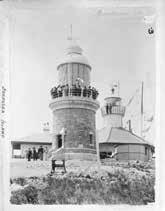
3 minute read
The lighthouse girl
By Peter Strachan
Fay Howe, the lighthouse keeper’s daughter at remote Breaksea Island, was already a remarkably accomplished young woman at the outbreak of World War 1 in 1914. But it was her kindness, unstinting effort and telegraph skills that left her warmly remembered by Australian troops sailing to war from Albany. For many troops, Fay was the last opportunity to get messages back to their loved ones.
Advertisement

Faye Howe: Acclaimed daughter of the Breaksea Island lighthouse keeper.
Image supplied by the Albany History Collection courtesy of Don Watson and the extended Watson family.
Fay was born in 1899 at Cape Leeuwin Lighthouse, on the south-west tip of Western Australia. She was the youngest of Robert and Hannah Howe’s four children and was just six years old when her father was transferred to Breaksea Island.
Little was known of her early life, until author Dianne Wolfer began research for her book Lighthouse Girl in 2005.
‘Even then, a lot of what we now know emerged years after the release of the book, with help from Fay’s descendants,’ Dianne said.
A statement issued by family says that when Robert was appointed lighthouse keeper at Breaksea, only Fay and her parents moved to the island. The couple’s three older children, Harold, Evelyn and Ada, remained in Albany with relatives for their schooling.
As Fay grew up she became proficient with a gun and was soon able to contribute to family meals with mutton birds and rabbits. She also collected stinging nettles—often the family’s main green vegetable.
Fay became remarkably capable in many aspects of life—a very accomplished and confident young person. Her parents taught her to read, write, do arithmetic, crochet, sew and cook. They also taught her signalling with flags, semaphore, Morse code and telegraphy.
In 1913, when Fay was 13, her sister Ada gave birth, but died from a lung disease soon after. The baby, Stanley, was taken out to the island for Fay’s mother to rear, but unfortunately their mother died early the following year, leaving Fay to raise the child.
Around this time, shipping activity in Albany had increased dramatically. The first Australian Imperial Force fleet was formed to carry Army troops, horses and supplies to World War 1 battle theatres, and it was at this point that Fay’s acts became the stuff of legends.
Barely into her teens and with her sister’s baby to rear, adding to the demands of life on windswept, isolated Breaksea Island, a tireless and highly competent Fay transmitted many of their messages back to the troops’ families.
‘It’s not hard to imagine the thoughts of the soldiers aboard the ships, desperate to send a final message home to families on the eve of sailing and being unable to get ashore to a telegraph station or post office,’ Dianne said.
‘Some soldiers even wrote farewell messages which they put into bottles to throw overboard. Others signalled in any way they could, in the hope their messages would get through. And for many, they did, thanks to Fay.’
Afterwards, grateful soldiers sent postcards back to Fay, warmly thanking her for relaying their messages to their loved ones. For too many, of course, Fay’s transmissions were the very last messages they were ever able to send home—the treasured postcards Fay received were kept in a drawer, but have since been lost.
In 1915, James Watson was sent to Breaksea as a relief lighthouse keeper and he and Fay were married in December 1916. The couple bought a house on Duke Street, in East Fremantle, Western Australia, where Fay lived for most of her adult life. They had five children, three of whom— Doreen, Marjory and Don—survived to adulthood.
After James died in 1946, money was very short so Fay turned her skills to dressmaking and later became a wardress at Fremantle Women’s Prison in the 1950s.
Fay’s ‘can-do’ attitude led her to success against the many and varied challenges she faced in her life. At the time of her death in 1968, Fay left behind three married children and nine grandchildren.
Her generous spirit and willingness to help the departing soldiers is remembered in the book, Lighthouse Girl and the family statement can be found on Dianne’s website. www.diannewolfer.com

Breaksea Island Lighthouse 1858










